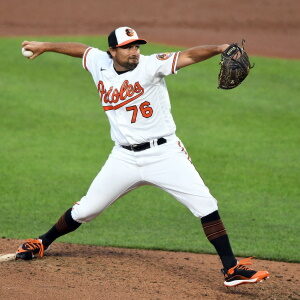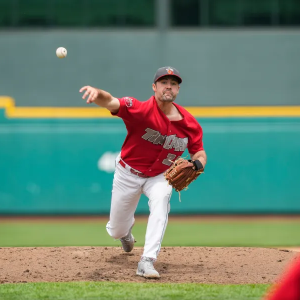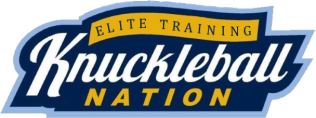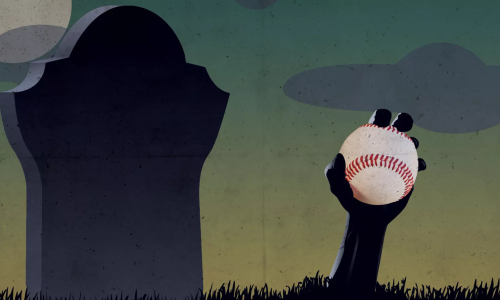The knuckleball seems to be sputtering out. The advent of tracking technology and enhanced training modalities are leaving the knuckleball behind. I’ve always been confident that the knuckleball would survive because it is effective at getting big league hitters out, and getting big league hitters out pays millions. But there seems to be a simpler way to get big leaguers out these days — throw 100 miles per hour.
The Edgertronic slow motion camera is capable of filming at thousands of frames per second. You can really break down throwing mechanics effectively once you get past the fact that the camera adds 10 pounds and that you can see that added weight juggle around your body in slow motion. This has led to breakthroughs in understanding the movement patterns that maximize velocity. Trainers have produced extremely effective workouts using cutting edge training to maximize the athlete’s power through those movements to maximize velocity.
Now, an athlete can walk through the doors of a velocity training facility like Beimel Elite Athletics in Los Angeles, California, to max out on velocity in a single off-season. The owner of Beimel’s is Joe Beimel. The man pitched 13 years in the Major Leagues before retiring at 38. He was throwing 90 miles per hour, but he went home and decided to throw harder. He used all of the new information available to him to craft 95+ mile-per-hour mechanics to make a comeback at the age of 45. He made it all the way up to Triple-A that season.
Joe knows everything about throwing harder, so he opened Beimel Elite Athletics to help others reach their potential. Now there’s a velocity board hanging in the facility with multiple 100+ mile-per-hour readings.
So, if you’re a pitcher who’s gone through the High School and College grind, then you have a very easy decision to make on your path into the pros. You can either bank on the automatic option — train at Beimel Elite Athletics to get more powerful in order to throw harder — or you can commit years of frustration to the knuckleball with no real guarantee of success.
Scouts Can't Scout It
Here’s the real issue with the continuance of the knuckleball — baseball is a business.
Everyone is scared of losing their jobs no matter what job it is. Now, imagine that you’ve worked hard to crack into the executive side of baseball. You make decisions on which players to draft, which free agents to sign and which players to keep even if they are having a slump. All of your decisions either win games and develop Major Leaguers or they lead to losses and subpar players.
So, you have a decision to make. You can draft or sign the guy throwing 95+, or you can risk your reputation on a knuckleballer.
Making this decision even easier is the tracking tech. You can see the conventional pitcher’s spin rates, average break, ability to throw strikes, spin axis and true spin. The computers tell you if he’s throwing well. But, with the knuckleballer, there is no protocol. None of the trackers do a good job of tracking the knuckleball, so spin rates are not a very good indicator of skill. And none of the trackers are capable of seeing multiple breaks, so none of the data shows the true devastation of the pitch.
It’s pretty simple. To keep your job, you’d sign the kid throwing 95+ with good spin rates over the knuckleballer with no quantifiable data.
That’s the way it’s going to be until the technology is able to track the knuckleball successfully and someone puts together a scouting protocol using the data. Because right now, teams can tell if a kid will age into velocity. We need a system that tells teams that a kid will age into a legendary knuckleball.
Knuckleball Pitchers 2022 of Note
Mickey Jannis
Matt Waldron


Mickey Jannis served as guest instructor for Knuckleball Nation’s 2022 annual knuckleball clinic in Las Vegas. The clinic takes place every Columbus Day Weekend in October and has been running for 10 years.
He joined Knuckleball Nation after cracking into the Major Leagues in 2021. He made one relief appearance against the vaunted Houston Astros. He cruised through the first inning but baseball’s best offense got to him in subsequent innings. Unfortunately, his 80+ mile-per-hour knuckleball was released by the Baltimore Orioles at the end of the season.
He played at the highest level of Independent Professional Baseball in 2022 putting up impressive numbers for the High Point Rockers and is looking for a big league opportunity in 2023. He’s not young at 36, but knuckleballer’s are immortal, he keeps getting better and he’s definitely got the arm strength.
Matt Waldron has made a name for himself in the San Diego Padres organization. He was teammates with Joe Beimel, the owner of Beimel Elite Athletics in Los Angeles, California, during Joe’s 45-year-old comeback.
Waldron has been cruising at Double-A San Antonio for the Padres, but scuffled a bit at Triple-Al El Paso. The problem might simply be high and dry air as El Paso sits a mile high in the desert. The knuckleball doesn’t move to well in those conditions, so his numbers might be inflated at Triple-A.
The most remarkable thing about Waldron is his ability to throw hard. This is the way the game’s been trending, but it’s a rare sight when a knuckleball can cruise in at 85 miles per hour only to be backed up by a 95 mile-per-hour fastball.
It’ll definitely keep the hitters on their toes. The only concerning thing about Waldron is his spin rate. The minor league parks can use very sophisticated tracking technology, and the only spin rates that I’ve seen on Waldron are in the 500’s. That’s a concerning amount of spin.
But, if he can learn how to kill the spin with such a powerful arm, then we might be looking at our first knuckleballer with a 95 mile-per-hour arm.



